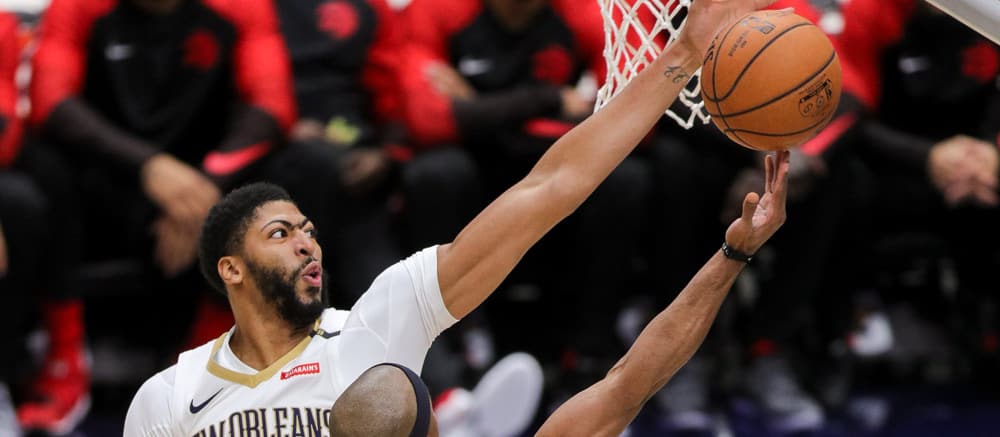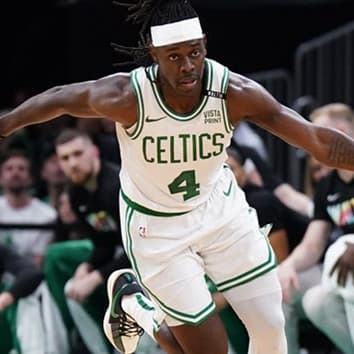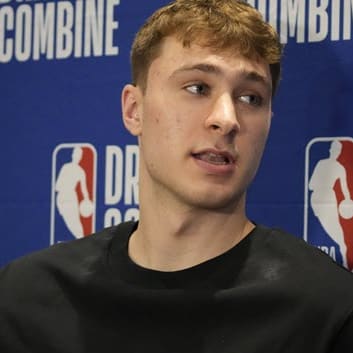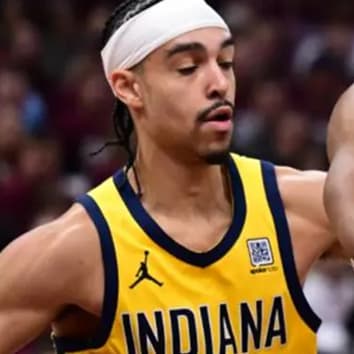This article is part of our Numbers Game series.
Most NBA fans know about the NBA's scoring boom. Other than the epochal dominance of LeBron James and the Warriors, the dramatic shift in NBA offenses has been the biggest NBA storyline this decade.
For the new or the uninitiated, the short version is this: long, long ago (circa 2007-2010), in a galaxy far, far away (Houston), a man did some complicated math to determine that three is a bigger number than two. Around that same time, the Warriors drafted two of the greatest long-range shooters of all time. What started with the Rockets and the Warriors spread quickly, and the number of three-pointers made league-wide has increased every year since the lockout-shortened 2011-12 season. The number of points scored league-wide has increased nearly 10 percent during that time.
It's easy to draw a straight line from "more threes are made and more points are scored" to "the fantasy marketplace of threes and points is changing". And many articles, including several that I've written, dive into some of the impacts of this offensive shift.
But offenses don't exist in a vacuum – and defensive statistics are as important to fantasy as threes and points. The question naturally arises, therefore: how has the NBA's three-point bonanza changed fantasy's defensive landscape?
Narrowing Our Focus
Since so much of the offensive transformation stems from a shift in shot selection, this article will focus on shot-blocking. After all, it's only logical that a shift in what shots are attempted would most directly impact how shots are defended.
Blocks are what we math nerds call a dependent variable – a player can take a shot any time they want, but blocks are only possible after someone else has attempted a shot. If teams are changing the shots that they take, then there has to be a corresponding change in the frequency and distribution of shots that get blocked.
Specifically, fantasy managers need to know about three things:
Is the number of total blocks per season changing?
Is the distribution of blocks throughout the league changing?
For players on the fantasy fringes, do those who block shots also provide helpful (or, at least, non-harmful) production in other categories?
Answering those three questions will help us refine our drafting process, and will guide us on how to approach the waiver wire.
Looking for answers
Question One: Is the number of total blocks per season changing? Yes. But not by as much as I expected, and the trend is inconsistent.
I began my research with the 2012-13 season, the first season after the NBA lockout. Because of the lockout season's condensed schedule (fewer total games, and more games per week), it is a nightmare for valid data analysis. Since most of the scoring boom has taken place after that season anyway, it is a convenient transition point.
The number of blocks league wide have decreased by about seven percent between 2012-13 and 2017-18. However, if we had started this research just one season later, then we'd actually see a slight increase in total blocks per season. Looking at all six seasons, there is a clear downward trendline overall, but the decrease in blocks is minor and not remotely as consistent as the increase in threes and points.
The decrease in blocks season-to-season is minor enough, and inconsistent enough, that it alone does not warrant fantasy attention. That said, when combined with the conclusions below, it might become relevant.
Question Two: Is the distribution of blocks throughout the league changing?
Yes. The biggest chance in shot-blocking distribution is at the top of the league. The average number of blocks per game for the top-10 shot-blockers has fallen steadily throughout our sample. The rate of decline was nearly constant and very consistent. Over the six seasons studied, the top 10's average blocks per person per game has fallen from 2.3 to 1.7, a drop of more than 26 percent. At the beginning of this study, a fantasy roster might be able to dominate the field with two elite shot-blockers and not much more from their supporting cast. That is far less likely to be enough in 2018-19.
Throughout the rest of the league, the distribution of blocks hasn't changed much. Over the course of the sample, there has been a small decline in the number of blocks recorded by the 20th-best shot blocker, the 30th-best, the 40th, and the 50th. However, at all of those intervals the decline is not statistically significant. For now, we should assume that once we get outside of the top-10(ish) shot-blockers, the distribution of blocks among the next 40 spots in the ranks will be pretty consistent year to year.
Ok, so, the elite are blocking fewer shots, and the good are blocking the same number of shots – but didn't we just establish that the number of blocks league-wide wasn't really changing? Where are the other blocks going?
The drop in shots blocked by the league's elite leaves nearly 500 blocks that have to get distributed throughout the rest of the league. The first thing we have to remember is that those 500 blocks only make up a little less than five percent of the league's total blocks, so they might be impossible to find.
We already know they didn't go to the blocking upper-middle – the guys who block roughly 0.8 to 1.3 shots per game. Next place to look was if they went to the blocking lower-class – guys who block between 0.1 and 0.4 shots per game. Nope, not there either. The number of players who block between 0.1 and 0.4 shots per game is effectively unchanged since the lockout.
The evidence is shaky, but it appears as though the extra blocks are going to the wide middle-class of shot-blockers. The increase was inconsistent, but over time more players are blocking 0.5 shots per game, the equivalent of one block every other game.
These findings mean two things. First, securing dominance in blocks is harder than it used to be. It now requires more top-notch players, and more help down the roster. Second, with more blocks coming out of the wide middle, managers have to do a better job of avoiding absolute-zero shot-blockers. A roster can probably still sustain one or two, but the days when managers could rely on two great big men and without any support are probably over.
Question Three: For players on the fantasy fringes, do those who block shots also provide helpful (or, at least, non-harmful) production in other categories?
This is the hard one, and the most important.
The answer appears to be "yes".
Since the lockout, the number of players who average more than 0.5 blocks per game but are still bad fantasy commodities is decreasing. In 2012-13, 32 players blocked a at least one shot every other game but were still outside of fantasy's top-130 (the top-130 is the cutoff point for players who should be rostered in 10-team leagues). By 2017-18, there were only 20 mediocre-or-better shot blockers that were not good fantasy assets. That decline in fantasy-useless, OK shot blockers came despite an increase in the total number of OK shot blockers.
In 2012-13, 15 players ranked in the top 50 in blocks, but outside the top-130 for fantasy. That number dropped steadily such that, by 2017-18, it was down to only seven – a drop-off of more than 50%.
This has huge fantasy implications.
Earlier this decade, a manager in desperate need of blocks could always turn to the waiver wire. There were bound to be several quality contributors who were widely available because of their deficiencies in other categories. This was particularly important in head-to-head leagues. Late in a close matchup, a manager might find a player capable of providing the decisive blocks. Better still, they could choose between several options, maximizing schedules and selecting the player best suited to the battle at hand. Now, with so few decent shot-blockers unworthy of rostering, those late-week additions are less available, and the ones who are there are less helpful.
Second, because there are so few shot blockers who should go unrostered, managers are incentivized to hold onto defensive talents who otherwise would not warrant a roster spot. This depletes the pool of potential shot blockers on waivers even further.
Conclusions
The three-point/scoring bonanza has, indeed, changed fantasy's shot-blocking landscape. The overall number of blocks league-wide has barely changed, but they are now distributed differently throughout the league. The game's best rim protectors are blocking fewer shots, while more players are providing marginal help in the range of roughly 0.5 to 0.7 blocks per game. Finally, there are significantly fewer players who block shots but are otherwise bad fantasy options.
This impacts fantasy leagues in several ways:
- First, managers can no longer rely on a "set it and forget it" strategy of simply rostering a few really good shot blockers and then not thinking about the category. Those top-tier players are blocking fewer shots, and opponents are getting more help from the category's wide middle class.
- Second, it is now harder to hold onto multiple absolute-zeros in the category. Teams are getting more from the middle of their roster, so a roster that throws out several players like Chris Paul, Tim Hardaway Jr. and Evan Fournier will have a harder time keeping up – even if they also have a couple Rudy Gobert-types.
- Third, blocks are becoming significantly more rare on waivers. There are fewer mediocre-to-good defensive players that "deserve" to be unrostered (according to their overall rank), and their relative scarcity increases the actual value of picking up any consistent shot-blockers that emerge – regardless of their contributions in other categories.
This points is especially important in daily lineup head-to-head leagues. In those formats, players like Maxi Kleber and Zach Collins aren't just potential prospects, they are borderline must-adds for teams trying to win blocks consistently.
In all leagues, prospects like Jonathan Isaac and Mo Bamba have significantly increased appeal. In this new reality, managers should have much more patience with someone who might provide multiple blocks per week in the not-too-distant future.












